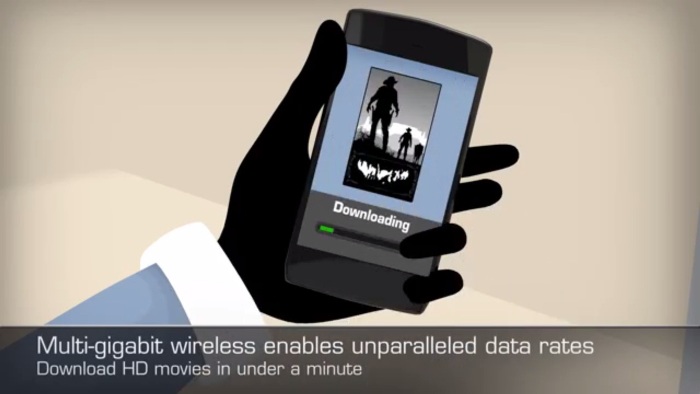WiGig Enables Wireless Connections Up to Ten Times Faster than Wi-Fi
Wi-Fi is the preferred Internet connection option for many mobile users. It’s fast and the power consumption is lower than that of other options. However, something faster is about to become more widely available to the public and Qualcomm’s acquisition of Wilocity is one big step to make to make it happen. By buying Wilocity, Qualcomm will be able to get its hand on WiGig technology and pursue further developments. This technology is different from Qualcomm MU-MIMO we wrote about earlier, which promises three times faster Wi-Fi speeds.
Wilocity Acquisition
Qualcomm announced its acquisition of Wilocity on July 2, an exciting addition in the company’s rapidly expanding business. The purchase of Wilocity means that Qualcomm can now integrate WiGig technology into the company’s wireless products. Qualcomm has become one of the top, if not the top, manufacturers of microprocessors for mobile devices. Having access to the technology being developed by Wilocity strengthens Qualcomm’s chances of becoming the leader in the wireless connection standard that would succeed Wi-Fi.
Wilocity is a company that lays claim as the first to deliver 60 GHz multi-gigabit wireless chipsets based on the newly completed WiGig standard used in consumer electronics, mobile computing devices, and computer peripherals. Established in 2007, Wilocity was founded with a clear goal of focusing on wireless technologies. The company was and continues to be involved in the development and production of wireless products for various applications including wireless docking, low latency HD display, and high-speed synchronization. As the company becomes a part of Qualcomm, its technologies are expected to be developed further and become accessible to more users worldwide.
WiGig
Also known as 802.11ad and Wireless Gigabit, WiGig is a new Wi-Fi technology that promises multi-gigabit speeds of wireless connections or up to ten times faster than the current Wi-Fi standard. WiGig uses the 60 GHz band and has data transfer rates of up to 7 Gbps. This is more than 10 times speedier than the highest rate achievable in the 802.11n standard. It is around the same speed delivered by an 8-antenna 802.11ac transmission.
Specifications/Capabilities
These are the version 1.1 specification/capabilities of WiGig:
- Backward compatibility with the 802.11 standard or today’s Wi-Fi standard
- Extension for the 802.11 Media Access Control layer
- Support for data transmission rates of up to 7 Gbps
- Interoperability and communication at gigabit rates made possible by a physical layer (in WiGig certified devices) that enables low power and high performance
- Support for specific system interfaces enabled by protocol adaptation layers, specifically for PC peripherals and display interfaces employed by HD televisions, monitors, and projectors
- Beamforming support, enabling reliable communication even beyond 10 meters
- Advanced security and power management
Uses
As implied by the specifications established by the Wireless Gigabit Alliance, WiGig specifications particularly benefit display extension as well as bus and serial extension. WiGig supports the fast wireless transmission of audio/visual data and enables wireless DisplayPort and other display interfaces including the High-bandwidth Digital Content Protection 2.0 feature. WiGig also enables multi-gigabit wireless connectivity between two devices (example: storage to high-speed peripherals) and defines high-performance wireless implementations of widely used computer interfaces on the 60 GHz band.
Qualcomm’s (with Wilocity) WiGig implementation is dubbed as a tri-band wireless solution as it combines Qualcomm’s dual-band Wi-Fi with Wilocity’s WiGig. Because of this cutting-edge implementation, the following features are enabled:
- High speed media streaming to augment a home Wi-Fi network with an ultrafast zone
- Instantaneous downloads with a thousand photos uploaded within 5 seconds
- Wireless docking and display, making it possible to have fully wireless computer systems (no cords between the computer monitor, mouse, keyboards, speakers, modems or routers, etc)
Not Meant to Replace Wi-Fi
Upon learning how fast WiGig is, you might think it will be a replacement to Wi-Fi. It is unlikely going to be the case, though. Because WiGig operates on the higher frequency band, it has the limitation of only working at shorter distances. As such, it can’t match the high speed and farther-reaching Wi-Fi technology most users are currently enjoying. WiGig can only reach about 30 feet while the present high speed Wi-Fi networks operating at 2.4 GHz or 5 GHz can reach hundreds of feet. Also, WiGig is incapable of going through walls in the same way current Wi-Fi does. Nevertheless, WiGig signals can propagate by bouncing on walls to cover wider areas.
You may be wondering why there is a need to create a new name, why was it necessary to come up with the WiGig branding instead of just sticking with the already popular Wi-Fi designation. Wireless Gigabit Alliance says that this is to avoid confusion because of incompatibility issues. Not all devices that support Wi-Fi can work with the WiGig band although WiGig devices will be able to work with Wi-Fi connections.




